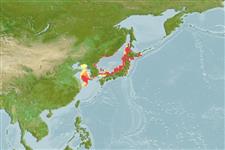Environment: milieu / climate zone / depth range / distribution range
Ecology
Marine; demersal; depth range 48 - 200 m (Ref. 58496). Polar; 2°C - 6°C; 50°N - 30°N
Northwest Pacific.
Size / Weight / Age
Maturity: Lm ? range ? - ? cm
Max length : 12.4 cm SL male/unsexed; (Ref. 27737)
Dorsal spines (total): 8 - 9; Dorsal soft rays (total): 18 - 19; Anal spines: 0; Anal soft rays: 14 - 15. Body elongated, slightly compressed. Head large, compressed. Eyes and mouth large. Parietal spines usually absent. Nuchal spines short, sharp, posteriorly or dorsally directed. Generally body shape and head more slender than other Icelus. Lateral line scales extending past posterior edge of hypural plate, one lateral line scale on caudal fin. A pair of caudal peduncle scales present. Reticulate white vermiculate lines on lateral body surface. Small scales bearing a minute prickle scattered sparsely on dorsal surface of the head. Pectoral fin rounded, reaching to above 1st anal ray; no soft rays branched. Pelvic fin slender, not reaching 1st anal ray. Anal rays unbranched. Each fin membrane thin, easily torn (Ref. 27737).
Specimens were collected from sandy-muddy bottoms (Ref. 27737). Minimum depth reported at 200 m (Ref. 27737).
Life cycle and mating behavior
Maturity | Reproduction | Spawning | Eggs | Fecundity | Larvae
Murai, T., T. Nakabo and T. Kinosita, 1994. A record of the cottid fish, Icelus stenosomus from southern Sea of Japan. Jap. J. Ichthyol. 41(3):343-346. (Ref. 27737)
IUCN Red List Status (Ref. 130435: Version 2024-1)
Threat to humans
Harmless
Human uses
Tools
Special reports
Download XML
Internet sources
Estimates based on models
Preferred temperature (Ref.
123201): 1.8 - 13.5, mean 7.1 °C (based on 29 cells).
Phylogenetic diversity index (Ref.
82804): PD
50 = 0.5000 [Uniqueness, from 0.5 = low to 2.0 = high].
Bayesian length-weight: a=0.00589 (0.00281 - 0.01234), b=3.15 (2.97 - 3.33), in cm total length, based on LWR estimates for this (Sub)family-body shape (Ref.
93245).
Trophic level (Ref.
69278): 3.5 ±0.4 se; based on size and trophs of closest relatives
Resilience (Ref.
120179): Medium, minimum population doubling time 1.4 - 4.4 years (Preliminary K or Fecundity.).
Fishing Vulnerability (Ref.
59153): Low vulnerability (10 of 100).
